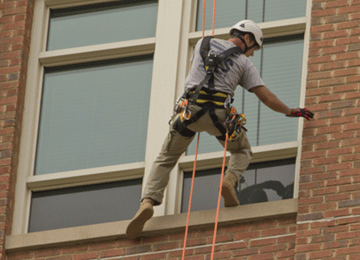Have you ever been walking down the street, looked up, and wondered if that window washer was crazy? Window cleaning is an industry assumed to be hazardous because it ‘looks dangerous’ to rappel in an urban environment. It requires care, focus, and attention to safety requirements, but in fact, it’s actually a relatively safe working environment.
Window washing is regulated by ANSI /IWCA I-14.1-2001 (International Window Cleaning Association) and enforced by OSHA. OSHA has a simple eight-point memorandum with basic “stay safe” guidelines; issued in 1991. ANSI has since teamed up with the IWCA (International Window Cleaning Association) to produce a commonly referenced industry standard the ANSI – I-14.1 “Standard for Window Cleaning Safety.” The standard has two sections; one for owners and one for users. The basics of the owner portion include:
- Providing the proper number and type of anchors for safe access to the building perimeter.
- Each point of descent (location of rappel at building parapet wall) must have two independent anchors within 15 degrees perpendicular to the wall being accessed.
- Anchors near exterior corners of the building need to be placed to prevent swing-falls.
- Each anchor needs to be rated for
- four times the rated load, or
- 5,000 pounds, whichever is greater.
- Each anchor needs to be load tested and certified for use by a Professional Engineer:
- prior to use,
- every ten years, and
- in conjunction with a roof replacement
- An annual visual observation of the anchors must also be conducted by a “Competent Person” as defined by OSHA (see “Safety and Health” topics on the OSHA website for more details).
- Providing a “contractor use plan” to describe the Owner supplied equipment to the end user of the equipment.
There are reasons beyond window washing why vertical exterior wall and roof access might be required, such as to perform visual assessment and/or testing of exterior wall sections, building facades, windows, caulking, or other exterior building elements as part of a property condition assessment program. These tasks also require consulting professionals to know and understand the requirements associated with implementation and maintenance of a fall protection system. This knowledge, when properly applied, allows for safe access for workers and provides adequate protection to help ensure public safety.
For more information about vertical access and fall protection, or should you have a project that requires roof anchor testing, inspection and design services, feel free to contact our regional experts: in the Carolinas, contact Pete Domenico, P.E.; in the Mid-Atlantic region, reach out to Michael Sladki, P.E., and in the Midwest, write to Gary Syslo, P.E.

